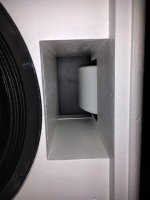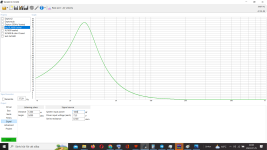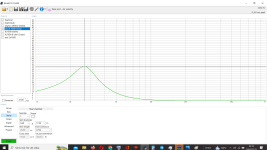Walls are no problem S, i built the house my self 14 years ago with "stone-walls" everywhere ( also inside walls 19 cm) outerwall is 42 cm thick.What mayhem13 said, you should hit 20Hz with room gain and a minimal eq. and - at spl max - I have the suspect your walls be shaking. I would seriously consider a room treatment. With your current box you have this (Fb is about 48Hz / F3 is 47Hz)
F3 at 47 hz diden´t sound so "funny", i was hoping on an F3 around 35-ish
But maby i can make the boxes i have "more" beautiful... but I doubt it!,,,you can´t make up a monkey to look good.
PS: My sister have live in Bologna for 40 years, trying to living on horses!...cavalli al trotto
Regards john
My wish ( from the begainning) was it could fit good in 70 liter, so quite big diffarance if that had work out.Just leave them alone then and get yourself a 2x4 mini dsp with DIRAC or get a measurement microphone and download REW if you don't already have it......not sure there's any value in building new boxes to say 25 liters of space.
And i have a cal microphone and use REW.👍
God i wish i could do that in my family room......i have OB 18's in my studio control room and that's all i'm permitted. LOL
Yes, you have to meet "your girl" when you allready have ton´s of equipment in your livingroom/house.
Their after she will be so glad, if you take only a bookshelf speaker away 😉 ( but im now living alone since having relationships since young age, and don´t complain even if i want to have a "gilr" in the bureau, and & bring out now & then.
Yes Italy maby have smaller "standads"regarding to Sweden, sound horrible if you even cant have a floorstander 10"I feel you! I do not have place for one of them in my living room: actually it's so tiny that I could have problem with a floorstander with a 10" woofer
regards John
The funny thing is that I have just translated a story about a monkey...
Bologna is a nice city and the people of Emilia Romagna are wonderful.
My room is strange, it's not rectangular, and 3 sides (out of 5) of it have windows and/or a balcon door: yep I have big fancy balcons and tiny/not so big rooms, and a lot of furnitures.
Back to business
If you reduce the area of the vent to 160cm2 (16x10cm) and keep the 27cm lenght you can get this (Vb 125L @ 32Hz)

And with a 6dB eq / LR4 at 120Hz you get a F3 at 30 Hz (air velocity should not be an issue.

Ciao
S.
Bologna is a nice city and the people of Emilia Romagna are wonderful.
My room is strange, it's not rectangular, and 3 sides (out of 5) of it have windows and/or a balcon door: yep I have big fancy balcons and tiny/not so big rooms, and a lot of furnitures.
Back to business
If you reduce the area of the vent to 160cm2 (16x10cm) and keep the 27cm lenght you can get this (Vb 125L @ 32Hz)
And with a 6dB eq / LR4 at 120Hz you get a F3 at 30 Hz (air velocity should not be an issue.
Ciao
S.
Funny you say that!If you reduce the area of the vent to 160cm2 (16x10cm) and keep the 27cm lenght you can get this (Vb 125L @ 32Hz)
When i did the "re-build" before I reduce the port to 9,4 X 17,5 cm = 164,5 cm2...Quite near 😉
But it´s hard to calculate the handle inside!
Attachments
70 liters is just too small.......you're going to have to remember/ consider thermal issues too with a sealed enclosure.......the heat has no where to go and your box is gonna reach thermal equilibrium pretty quick. From there, it's all down hill with thermal and power compression..........you'd be better off with a 15" driver or wish you had.
In a box of 131 liters, tuned to 33 Hz this driver would give you -3dB at 35 Hz., -6dB at 31 Hz and -12 dB at 24 Hz. Not that bad at all but it is definitely important to not skimp on Vb.
Regards
Charles
Regards
Charles
Was thinking about that, but 70-80 lit vented maby is a different story?70 liters is just too small.......you're going to have to remember/ consider thermal issues too with a sealed enclosure
Although a 70-litre vented box is possible, it is far from ideal. The 18XL1600's Thiele-Small parameters are such that it is not suited to small vented enclosures. below is a plot of the results when a 70-litre vented box is used. The SPL output of the vent (red line) is quite low, and adds only a little bass reinforcement. comapred to a closed-box enclosure.

I was curious as to how much extra bass response we could get from a 70-litre vented-box loudspeaker enclosure if we applied a lot of EQ. Hence, this is purely a theoretical design exercise.
Below is the resulting response, with f3 = 36.7Hz. Note that for a nominal 100W input into this driver, the EQ needs to be able to produce about 570 watts near 40Hz!

The EQ settings for the electronic filtering are shown below.

Below is the resulting response, with f3 = 36.7Hz. Note that for a nominal 100W input into this driver, the EQ needs to be able to produce about 570 watts near 40Hz!
The EQ settings for the electronic filtering are shown below.
Whats wrong with low output from port?Although a 70-litre vented box is possible, it is far from ideal. The 18XL1600's Thiele-Small parameters are such that it is not suited to small vented enclosures. below is a plot of the results when a 70-litre vented box is used. The SPL output of the vent (red line) is quite low, and adds only a little bass reinforcement. comapred to a closed-box enclosure.
View attachment 1338478
Port spells distortion...
The benefit of using a big driver is to reduce distortion to very low levels that matches distortion above 100 Hz.
You should be focusing on what really matters. Finding the right and best solution for the room these drivers are intended to be used.
Best principle of cabinet for low distortion is a sealed cabinet.
This driver gives too little deep bass from 50 Hz and below in a sealed cabinet, and is better used in a bass reflex configuration.
Because of the high stiffness of suspension this driver is very tolerant to changes in cabinet volume.
As I see is, maximizing the extention and have an increasing amplitude of bass below 50 Hz means more distortion and a deviation from a flat frequency response when placed in a room.
I do not think that is a good idea if ultimate sound quality is the objective, only for the sole purpouse of maximizing bass output.
I think you are focusing on the wrong thing, but that is my opinion, and as it seems jawen also want to maximize bass output instead of maximizing accurate sound potential.
What's wrong with low output from the port? Well, if the aim is to have an extended bass response in a viable system, then the low port output is less than ideal as it isn't helping all that much in achieving that goal.
I take your point that "port" spells "distortion". Having said that, if one is trying to reproduce low-frequency content that is in the program material, and can't, then that is also distortion.
It is being kept in mind that there are some existing drivers on hand, which need to be used. Exploratory analysis of a few different design options might be considered to be potentially instructive.
I take your point that "port" spells "distortion". Having said that, if one is trying to reproduce low-frequency content that is in the program material, and can't, then that is also distortion.
It is being kept in mind that there are some existing drivers on hand, which need to be used. Exploratory analysis of a few different design options might be considered to be potentially instructive.
@witwald
By not taking room gain into the equation to solve, you just extend bass without considering that you are creating a peak when the speaker are placed in the room. Room size, and where the speakers are intended to be placed are just as important as tuning the speaker.
By just focusing on extension and not considering room contribution you are at risk creating more distortion and a peak in frequency response.
I have decided not to take part in this discussion since jawen is in line with just focusing on bas extension.
But it is just so anoying that I couln't keep my mouth shut.
Sorry, now continue with your quest for maximizing bass extention.
By not taking room gain into the equation to solve, you just extend bass without considering that you are creating a peak when the speaker are placed in the room. Room size, and where the speakers are intended to be placed are just as important as tuning the speaker.
By just focusing on extension and not considering room contribution you are at risk creating more distortion and a peak in frequency response.
I have decided not to take part in this discussion since jawen is in line with just focusing on bas extension.
But it is just so anoying that I couln't keep my mouth shut.
Sorry, now continue with your quest for maximizing bass extention.
Last edited:
That peak would be very easy to tame with DSP and this way you can have a lower distortion system with deeper extension as well and probably more max SPL (above the port tuning). Just need to do the porting carefully. BTW a low tuned ported speaker can have a similar gradual roll-off (above the tuning frequency) as a sealed speaker, even without DSP.By just focusing on extension and not considering room contribution you are at risk creating more distortion and a peak in frequency response.
But one issue that I see with ported vs sealed box in this very case is the size difference. Small ported boxes are harder to tune low, of course it can be done but it requires long ports which have its own problems (like pipe resonance) and the OP wants to use the woofer section up to 250 Hz where this can be a problem. Or need to use larger ported box but the OP wanted small boxes.
Last edited:
Tamed in one place yes (kinda), but room modes will change throughout the space and modal peaks will also create troughs that cannot be addressed through DSP.
It’s a bit more complicated than just eliminating a peak.
It’s a bit more complicated than just eliminating a peak.
A couple of notes from me:
If output is a concern, a ported box is the way to go. IMO, 2x 18"s per side in sealed boxes will have more than enough output in a domestic situation.
It's also worth noting that ported boxes produce basically zero useful output below their tuning frequency, so you'd be limiting the LF extension available by going that route.
Chris
- I currently use the Faital Pro 18XL1800 in compact sealed boxes for PA use. To avoid heat buildup, I've connected the pole vent to the outside world via a short tunnel at the back of the cabinet. When they're really pushed hard (Powersoft T602 bridged into a pair of subs, nudging the limiter for a few hours), slightly-warm air is expelled, so I guess that means the vent is keeping the drivers reasonably cool. The bit of the magnet structure I could get to was only warm to the touch.
- I used those same cabinets to try a 3-way design, with a BMS 4592 on a 400Hz horn. The crossover was 450Hz, and it sounded excellent once the mid-high range was EQ'd. I used a T602 for the 18"s, and a T304 for the horns. The LF cabinet was stuffed pretty tightly with polyester fill, to soak up any standing waves towards the crossover point.
If output is a concern, a ported box is the way to go. IMO, 2x 18"s per side in sealed boxes will have more than enough output in a domestic situation.
It's also worth noting that ported boxes produce basically zero useful output below their tuning frequency, so you'd be limiting the LF extension available by going that route.
Chris
If you use speakers with not as deep extension, the room problem (peak) is still there just not as excited as with a deeper extension speaker because the speakers simply don't pump as much relative SPL at the problematic region as a speaker with a deeper extension. The DSP actually does the same, less SPL from the speaker to tame the in-room peak. DSP can easily be tuned to a specific room or placement with an existing speaker and the OP wants speakers that are good in general and not only for a specifc room.Tamed in one place yes (kinda), but room modes will change throughout the space and modal peaks will also create troughs that cannot be addressed through DSP.
It’s a bit more complicated than just eliminating a peak.
Last edited:
Completely agree, only one has to be careful and tune this to avoid reversing the problem ie making the system sound anemic.
I’ve worked with the excellent Linn no-mike ‘Space’ algorithm for years, installing systems in customer rooms, at shows etc, and it takes some skill to get this right.
I also have a Trinnov miked room correction system and let’s say it just aint easy to get this right, but in general sure - you’re correct.
Edit - And it’s not just a peak, it’s modes😉
I’ve worked with the excellent Linn no-mike ‘Space’ algorithm for years, installing systems in customer rooms, at shows etc, and it takes some skill to get this right.
I also have a Trinnov miked room correction system and let’s say it just aint easy to get this right, but in general sure - you’re correct.
Edit - And it’s not just a peak, it’s modes😉
Hi, have you posted any details how you actually implemented the tunnel? Thanks!A couple of notes from me:
- I currently use the Faital Pro 18XL1800 in compact sealed boxes for PA use. To avoid heat buildup, I've connected the pole vent to the outside world via a short tunnel at the back of the cabinet. When they're really pushed hard (Powersoft T602 bridged into a pair of subs, nudging the limiter for a few hours), slightly-warm air is expelled, so I guess that means the vent is keeping the drivers reasonably cool. The bit of the magnet structure I could get to was only warm to the touch.
- I used those same cabinets to try a 3-way design, with a BMS 4592 on a 400Hz horn. The crossover was 450Hz, and it sounded excellent once the mid-high range was EQ'd. I used a T602 for the 18"s, and a T304 for the horns. The LF cabinet was stuffed pretty tightly with polyester fill, to soak up any standing waves towards the crossover point.
If output is a concern, a ported box is the way to go. IMO, 2x 18"s per side in sealed boxes will have more than enough output in a domestic situation.
It's also worth noting that ported boxes produce basically zero useful output below their tuning frequency, so you'd be limiting the LF extension available by going that route.
Chris
Much like chris661, my Small PA uses 4 x 18" drivers in 55l sealed enclosures (Qts 0.5) and is way more than adequate for pub-sized venues. With the EQ and power available it will also produce enough LF to cause turntable feedback requiring a steep 28Hz high pass filter, and visibly flex the 1/4" plate glass windows in one particular venue. What spl at what frequency are you trying to achieve in a small listening room?Was thinking about that, but 70-80 lit vented maby is a different story?
If you are worried about heat buildup, mount the speakers reversed with their magnets in free air - my magnets remain at room temperature after 3 hours' use.
Last edited:
- Home
- Loudspeakers
- Multi-Way
- How small box can an Faital Pro 18XL1600 work good in?


